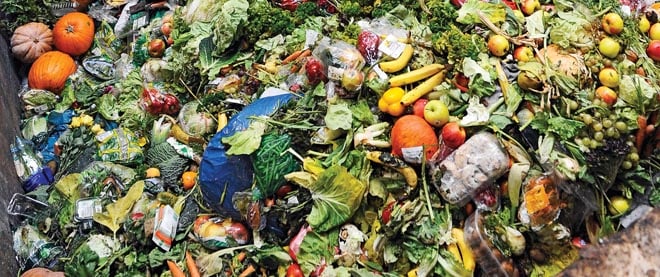The food-waste debate could use a pinch of common sense
From expiration dates to fruit aesthetics, $27 billion dollars worth of food are wasted annually
Tom Ryaboi
Share

That banana looks a bit brown. The yogourt is past its “best before” date. And no one else is eating those end slices, so why should you?
In the typical Canadian kitchen, the banana, yogourt and the bread crusts—and a lot more besides—are prime candidates for the garbage can or composter. With food cheap and plentiful, we’ve regrettably become a nation of picky eaters. An estimated $27 billion worth of food, or 40 per cent of what’s produced annually in Canada, is wasted between field and table, according to a recent study from the George Morris Centre in Guelph, Ont. More than half of that occurs at home.
This is not just a Canadian concern. In 2011 the Food and Agricultural Organization of the United Nations estimated 33 per cent of global food production, or 1.3 billion tonnes, is wasted per year. And last week, a report from the British Institution of Mechanical Engineers pushed that number up to an astounding 50 per cent—half of all food produced in the world is lost, misdirected or thrown away due to poor harvesting techniques, spoilage, inefficient distribution processes and overly dainty consumer preferences.
Food waste seems like an obvious issue that ought to unite everyone from environmentalists and social justice advocates to businesses and parsimonious consumers in common cause. Throwing away less food saves money, uses scarce resources more efficiently and leaves more for the poor to eat. How do we let so much food go to waste?
The recent British report found the developing world is most likely to lose food due to inefficient or outdated harvesting and distribution methods. In Ghana, for example, nearly half the corn crop was spoiled in storage in 2008.
Here in North America the problem largely stems from political and consumer preferences. Supply management, for example, punishes farmers who produce more than their quota and the excess is often destroyed. And blemished or undersized produce may be tossed at harvest or during packing and distribution as unfit for sale. But the greatest losses occur at home. According to the 2011 UN report, a third of all potatoes and other tubers bought by North American consumers are thrown out or wasted at home. The same fate awaits a quarter of all fruits and vegetables and 15 per cent of all dairy purchases.
It is an issue that last year earned the attention of Ontario’s environmental commissioner, who fretted over the huge amounts of energy required to grow, pick, pack, move, sell and cook all that uneaten food. “The environmental consequences of letting good food go to waste—up and down the food chain—are staggering,” wrote Gord Miller. He blamed poor meal planning, leftover avoidance and increasing demand for food that looks “perfect” for all that kitchen waste.
Beyond shopping more carefully, packing a lunch and being content with the occasional misshapen carrot, Canadians also need to lose their too-fussy perceptions of food risk.
Take best-before dates. According to the Canadian Food Inspection Agency, a best-before date (unlike an expiration date) simply signifies the point at which the product is at its peak. “You can buy and eat food after the best-before date has passed. However the food may lose some of its freshness and flavour, or its texture may have changed,” the CFIA says on its website. Perhaps not a ringing endorsement of tastiness, but neither is it a death sentence for that past-due yogourt tub. Too many consumers mistake “best before” for “dangerous after.”
Despite “best before” being irrelevant to food safety, many food banks and other charitable organizations refuse to take donations past the stamped date. Such policies foil efforts by well-meaning stores and distributors to reduce waste by donating perfectly edible food to needy Canadians.
Then there’s the XL Foods beef recall in Alberta last fall. While E. coli bacteria is a serious matter, it can be entirely eliminated by proper cooking. Yet an estimated half million kilograms of safe and edible meat was landfilled because the company figured no one would buy it. And when Alberta Wildrose party Leader Danielle Smith suggested quite properly that the precooked beef could be given to food banks, she was excoriated on social media for allegedly trying to foist “tainted meat” on the poor. The entire food-waste debate could use a pinch (or more) of common sense.
Food fills many roles, from the staff of life to a source of sublime pleasure. We should learn to waste it less and enjoy it more.